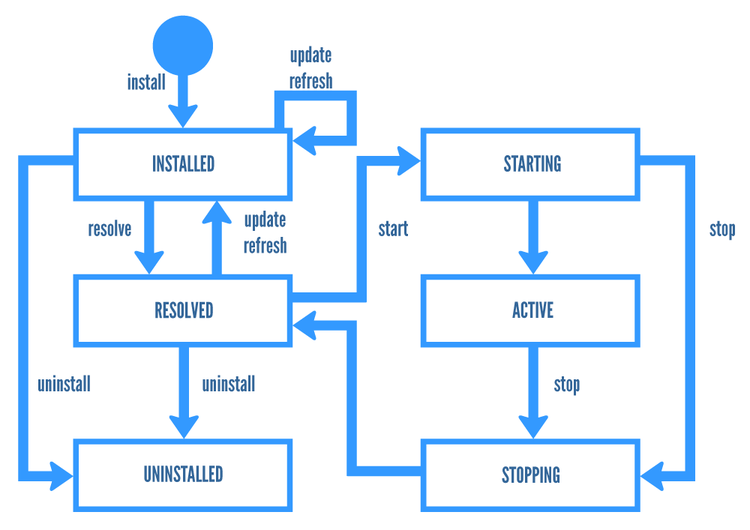Jahia OSGi Implementation
OSGi Framework startup
The OSGi framework is started once Jahia Spring context is instantiated. In turn, the FrameworkService initializes the Apache Karaf instance which registers all the bundles that will initially be started and made available to all deployed bundles. Of particular note, the FrameworkService loads its configuration from the digital-factory-data/karaf/etc/config.properties file that contains important settings such as which packages are made available to all bundles.
OSGi Servlet Bridge
The OSGi servlet bridge consists of two parts, a proxy servlet that is mapped as a servlet in the WEB-INF/web.xml file of the Jahia web application and then the actual bridge that will make it possible to call “regular” servlets inside the OSGi framework.
Jahia Module Extender
The core of the module integration is in the jahia/bundles/jahiamodule-extender project. Here, the Activator class is the starting point that registers the bundle listeners to listen for the deployment and undeployment of bundles and performs registration work inside Jahia. This is where most of the OSGi “magic” is happening, including the registration and dispatching to JSPs.
Bundle packaging
Jahia can have both system bundles that will be handled by Apache Karaf (such as Apache Karaf extensions) and Jahia bundles (common Jahia modules).
Jahia relies on Apache Karaf for system bundles. All the system bundles are in the Apache Karaf folder, by default at digital-factory-data/karaf. From here, you can use all the Apache Karaf framework to deploy any bundle, feature, or kar file. See more information here:
https://karaf.apache.org/manual/latest
Jahia has a watched directory located in digital-factory-data/modules that contains all Jahia installed bundles.
OSGi and Jahia Module States
Bundle life cycle
With the installation of a bundle in the OSGi runtime, the bundle is persisted in a local bundle cache. The OSGi runtime then tries to resolve all dependencies of the bundle.
If all required dependencies are resolved, the bundle is in the RESOLVED status otherwise it is in the INSTALLED status.
If several bundles exist which would satisfy the dependency, then the bundle with the highest version is used. If the versions are the same, then the bundle with the lowest install ID will be used (the bundle gets a unique identifier assigned by the framework during the installation). If the bundle is started, its status is STARTING. Afterwards it gets the ACTIVE status.
This life cycle is depicted in the following graphic:
Jahia extends the default OSGi lifecycle states to add intermediary states that give more information about the state of a module. You can find the description of these states in this table.
| State name | OSGi | Jahia | Description |
|---|---|---|---|
| UNINSTALLED | x | Bundle is not installed | |
| UNRESOLVED | x | Bundle is installed, but dependencies haven’t been resolved | |
| RESOLVED | x | x | Bundle is installed and all dependencies have been resolved |
| INSTALLED | x | x | Bundle was installed, but not started |
| UPDATED | x | x | Bundle was updated |
| STOPPED | x | Bundle was stopped | |
| STOPPING | x | x | Bundle is stopping |
| STARTING | x | x | Bundle is starting |
| WAITING_TO_BE_IMPORTED | x | Bundle is waiting to import its content, waiting for a dependency to import its content | |
| STARTED | x | x | Bundle is fully started and available |
| SPRING_STARTING | x | Bundle is started but is waiting for Spring context to be available | |
| SPRING_NOT_STARTED | x | Module failed to start due to an error creating module's Spring context | |
| INCOMPATIBLE_VERSION | x | The Jahia required version of the module is incompatible with the current one | |
| ERROR_WITH_DEFINITIONS | x | Bundle cannot start due to definitions error | |
| ERROR_WITH_RULES | x | Module failed to start due to an error compiling included business rules (Drools) |
Recommendations
As previously stated, when a bundle requiring a dependency is deployed, if this dependency is provided by several versions of a different bundle, then the highest version is used. This is an OSGi standard.
However, this may not work well with Jahia modules, which only allow one version of a module to be started/in use. When keeping several bundles of the same module on the platform, the dependency resolution will become unpredictable, as it will depend on the deployment order of your modules.
Simple example:
Module A depends on Module B.
| Scenario 1 | Scenario 2 |
|
|
This example shows how the order of the operations can impact the dependency resolution.
Even though Jahia tries to handle such situations by performing wiring refreshes upon deployment, because of transitive and circular dependencies it is not possible to address all the cases in a consistent way.
Listening to bundle states
You can listen to module state changes in another bundle by implementing a BundleListener. It's quite a common way to detect features in other bundles and react when they are installed or started.
However, you must be careful as BundleListener are asynchronous the state of the module may have changed by the time your listener is executed. Consider using SynchronousBundleListener instead if:
- you need to listen to a state change and want to be sure that the state has not changed again
- your listener performs any operation that might change the state of a bundle
